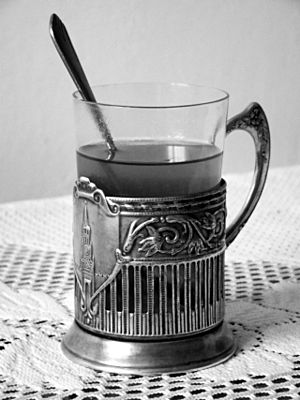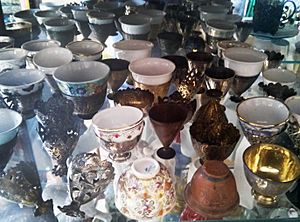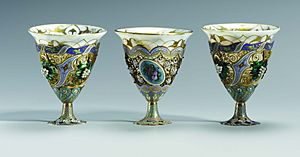Zarf facts for kids
A zarf is a special holder for a coffee cup. These cups usually don't have handles, like a small demitasse cup. Zarfs are often made from beautiful metal and are used to protect the cup and keep your fingers from getting hot. The word "zarf" comes from an Arabic word meaning "container" or "envelope."
Contents
The Story of Zarfs
Coffee was first discovered in Ethiopia. But it became very popular in Turkey around the 13th century. Serving coffee in Turkey, especially Turkish coffee, was a special and important event. It was a bit like the tea ceremonies in China and Japan.
Why Were Zarfs Used?
Coffee was served in small cups called fincan. These cups did not have handles. To protect the cup and keep people's fingers from the hot liquid, the cups were placed inside zarfs.
The cups were often made of porcelain, but also sometimes of glass or wood. Since the zarf was more visible, it was usually decorated much more beautifully than the cup itself.
From Old to New: Disposable Zarfs
In the late 1900s, coffee started to be served in cardboard cups. Because of this, zarfs also changed. They became disposable, too. The coffee cup sleeve you see today, often made of corrugated cardboard, was invented in 1991. It's like a modern zarf!
Different Kinds of Zarfs
Zarfs were often made from different metals. Silver, gold, copper, and brass were the most common. Some zarfs were also made from special woods like coconut or ebony. Other materials included ivory, bone, horn, or tortoiseshell. Today, the word "zarf" can also mean a cardboard coffee cup sleeve.
Metal Zarfs
Metal zarfs were often decorated in many ways. They could be filigreed (made with delicate metal wires). They might also have designs made by chasing (shaping the metal), niello (a black metal inlay), or engraving (carving designs). Sometimes, they were even set with precious stones!
Sets of zarfs decorated with enamel (a glassy coating) and gems were very popular in Islamic countries. In the 1800s, workshops in Geneva made many zarf sets for this market. These were decorated with bright enamel colors and designs like musical instruments or military symbols.
Other Materials
Wooden zarfs are very rare today. People liked them because of the natural smell of the wood. However, they were also very fragile and broke easily.
Zarfs made from tortoiseshell, horn, and ivory needed special skills to create. For tortoiseshell and horn, flat pieces of the material were softened in hot water. Then, they were pressed into a mold to get the right shape. Ivory was carved like wood. But because ivory was more valuable, carvers had to be extra careful not to make mistakes.




